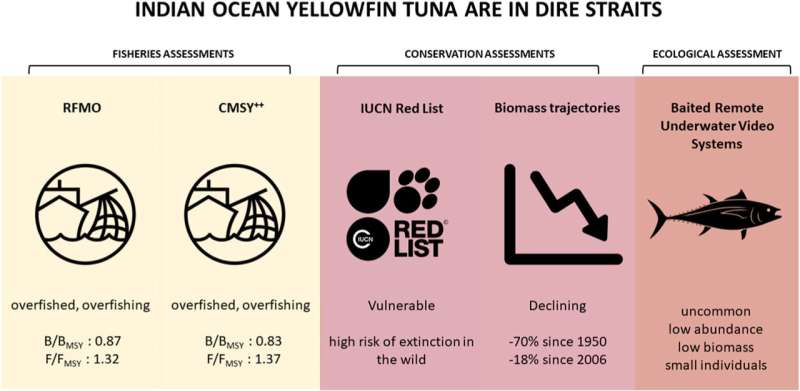This article has been reviewed according to Science X's editorial process and policies. Editors have highlighted the following attributes while ensuring the content's credibility:
fact-checked
trusted source
proofread
Tuna species popular in sashimi and poke bowls in sharp decline in the Indian Ocean

The yellowfin tuna commonly enjoyed in sashimi, poke bowls and salad sandwiches may soon disappear from these dishes if current over-exploitation rates remain unchanged, especially in the Indian Ocean.
A paper, titled "Multiple lines of evidence highlight the dire straits of yellowfin tuna in the Indian Ocean," and published in Ocean and Coastal Management shows that since industrial exploitation started in 1950, the global biomass—the weight of a given population in the water—of yellowfin tuna has decreased, on average, by 54% across the four populations managed by tuna Regional Fisheries Management Organizations (RFMO). In the Indian Ocean, yellowfin tuna biomass has experienced a 70% decline in the past 70 years.
"If we look at more recent years, we can see that global yellowfin tuna populations continue to struggle. Biomass continues to decline everywhere except for stabilizing trends in the Western Pacific Ocean, prompted by management interventions," said Kristina Heidrich, lead author of the study and Ph.D. candidate with the Sea Around Us—Indian Ocean at the University of Western Australia (UWA).
"In most places, extractions have regularly surpassed the maximum sustainable yield or MSY limit, which is the level that would allow for the highest possible catches to be sustained over time, given that environmental conditions don't change much," added Dirk Zeller, co-author of the study and director of the Sea Around Us—Indian Ocean.
To strengthen their evaluations, Heidrich and her co-authors used multiple methodologies. Since yellowfin tuna is normally assessed by RFMOs, they used the organizations' time series and assessment results of yellowfin tuna biomass to estimate its annual fluctuations from 1950 to 2020.
In parallel, they applied the CMSY++ approach, which relies mainly on time series of fisheries catches to assess the status of fish stocks. Finally, they analyzed 955 records of yellowfin tuna obtained from fisheries-independent sampling with Baited Remote Underwater Video Systems (BRUVS), which record biological and ecological data such as a species' size, biomass and how abundant it is in an area.
"The data collected with BRUVS provided a more holistic and fisheries-independent picture of the pelagic community and the status of the populations, which can complement fisheries-dependent data and analyses," said Jessica Meeuwig, co-author of the paper and director of UWA's Marine Futures Lab.
"These fisheries-independent BRUVS data suggest that, since 2014, yellowfin tuna in the Indian Ocean are the least common, least abundant, have the lowest biomass, and are the smallest yellowfin tuna in the existing dataset."
The CMSY++ approach, on the other hand, showed that even though yellowfin tuna exploitation rates slightly exceeded the MSY limit in the past decade in the eastern and western Pacific Ocean and in the Atlantic Ocean, these populations are not currently undergoing overfishing. That's not the case for the Indian Ocean, where overfishing is ongoing.
"Beyond yellowfin tuna fisheries contributing more than US$16 billion to the global economy yearly, the species is an apex predator that plays a critical role in the functioning, productivity and overall health of marine ecosystems," said Daniel Pauly, co-author of the study and principal investigator of the Sea Around Us initiative at the University of British Columbia.
"The risk of population collapse is high if current management does not adapt. Stringent management constraints must be implemented to reduce overall fishing capacity, rebuild overfished populations, and reduce the collateral damage these fisheries cause to other species such as sharks."
The researchers note that, by using multiple lines of evidence that cross-validate each other, such as the ones they employed, management organizations can improve the confidence, transparency and accuracy of the information that guides their decisions. They also propose stricter management measures such as a reduction of fishing capacity, ensuring that the MSY limit is observed and implementing effective catch limits.
"In the Indian Ocean in particular, a catch reduction of 30% from 2020 levels is urgent to halt and reverse the decline in yellowfin tuna population," Heidrich said.
More information: Kristina N. Heidrich et al, Multiple lines of evidence highlight the dire straits of yellowfin tuna in the Indian Ocean., Ocean & Coastal Management (2023). DOI: 10.1016/j.ocecoaman.2023.106902
Provided by Sea Around Us




















